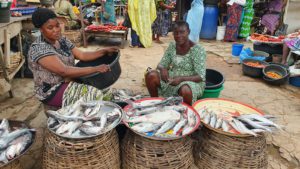Among the 120 million people who work in wild capture fisheries and post-harvest sectors, nearly 50 percent are women according to the Food and Agriculture Organization (FAO). Despite women’s key role in the sector, there is often limited awareness of their diverse contributions. In this interview, Our Shared Seas spoke with Dr. Sangeeta Mangubhai to discuss where women’s contributions in the fisheries sector are frequently overlooked as well as best practices for ensuring that both women and men can fully contribute to the solutions space for fisheries management.
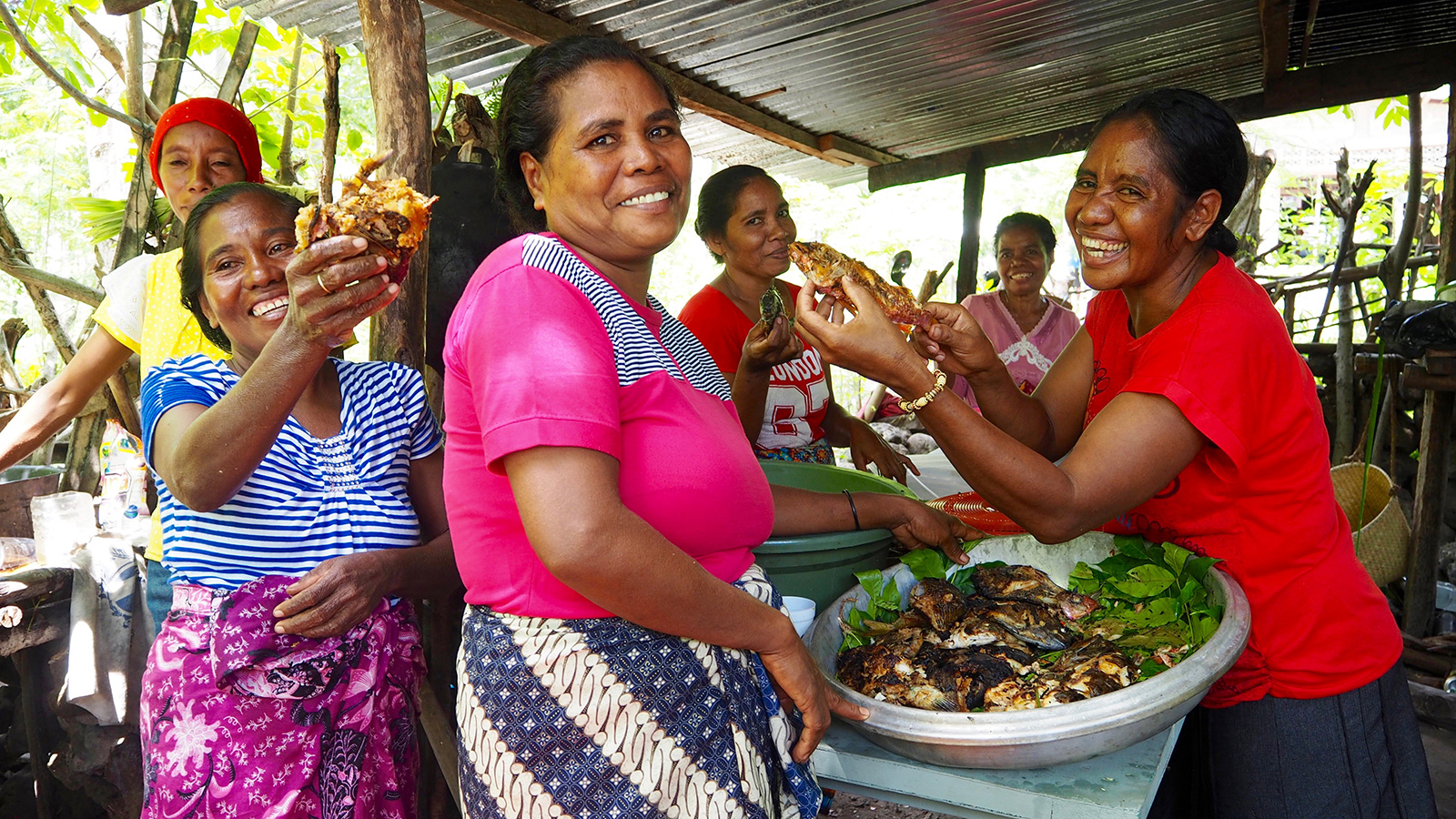
Margarida da Costa, Atauro Island, Timor-Leste. Photo: Kate Bevitt (via WorldFIsh/Flickr)
Dr. Sangeeta Mangubhai is a Principal Consultant with Talanoa Consulting. Previously, she was the Director of the Wildlife Conservation Society’s Fiji Country Program. She holds a Doctor of Philosophy in coral reef ecology from Southern Cross University. Originally from Fiji, she has worked on marine science and conservation in Australia, East Africa, Indonesia, and the South Pacific. With over 25 years of experience, Sangeeta works on community-based management, coastal fisheries, gender, fisheries, protected areas, land-sea planning, environmental policy, and climate change.
For those who might be new to this issue, can you provide an orientation on how and where women face barriers in fisheries production and management?
If you look at the fisheries sector globally, women make up nearly 50 percent of people operating in commercial and small-scale fisheries across the entire value chain. Women are playing a substantial role in the sector, but national statistics tend to overlook and undervalue their role. The fisheries sector is often blind to gender and the contribution of women—despite them playing diverse and multiple roles across the value chain, including performing many unpaid pre- and post-harvesting tasks such as bait collection, net mending, or the managing of accounts. In the Pacific and other geographies, women play an underestimated but significant role in subsistence fisheries (that puts food on the table), including through gleaning and other techniques which are not always recognized as an official type of fishing.
Because women are poorly recognized, they can face discrimination which may take the form of limited access to markets, harassment at markets, exclusion from training and information, lack of access to technology, poor access to finance facilities, and lack of opportunities to participate in national policy and local decision-making processes. If you look at boats, for instance, men often own and have access to them and women do not. Women frequently struggle to get funding for or access basic training that will allow them to secure a boat license.
If you look at the fisheries sector globally, women make up nearly 50 percent of people operating in commercial and small-scale fisheries across the entire value chain. Women are playing a substantial role in the sector, but national statistics tend to overlook and undervalue their role.
What are we “leaving on the table” when women are excluded or face additional barriers in participating in the fisheries sector? For those who care about marine conservation, why should they care about gender equality in fisheries?
We need to think about what we gain by including women, nearly half the population involved in the capture fisheries value chains. Women can operate in different ecological spaces than men for small-scale fisheries. In Fiji, for instance, women may spend more time in river systems and coastal habitats like mangroves and shallow reef flats. They have developed a wealth of traditional knowledge about these environments including the biology and reproduction patterns of species. By including women, we create the opportunity for them to bring this knowledge to the table to solve issues like overfishing. When we exclude women or other marginalized groups, we are losing the opportunity to access new, innovative solutions for the management of fisheries or habitat protection.
There’s also a high risk that we may roll out conservation initiatives, which at best, increase access to information and training but do not change women’s lives in a systemic way. At worst, if we don’t apply a gender lens and better understand cultural nuances, there’s an even higher risk of further exploiting women, widening the gap between men and women, and ultimately sending gender equality backwards rather than forward.
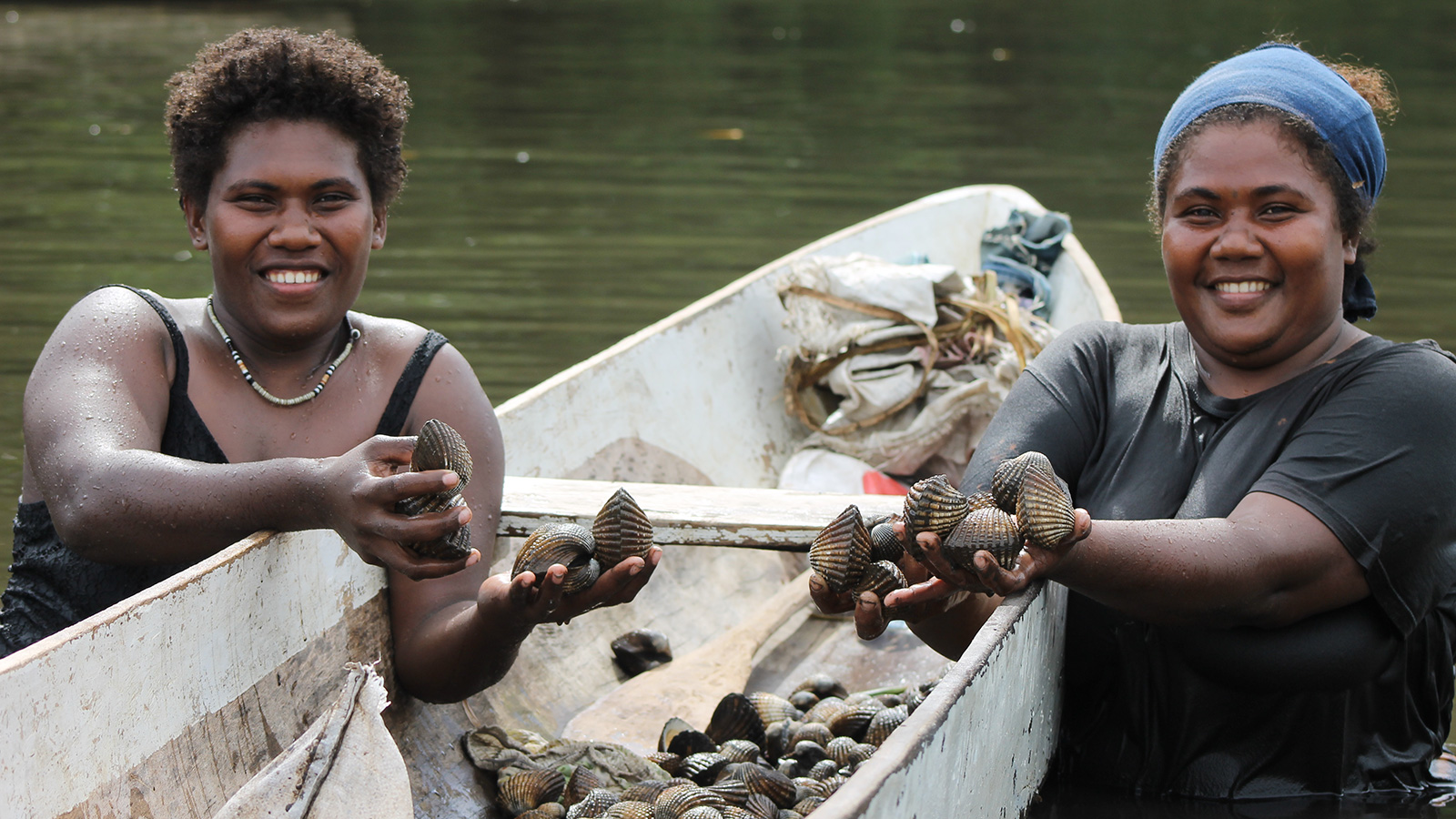
Women showing arc clams in Malaita, Solomon Islands. Photo by Meshach Sukulu (via WorldFish/Flickr)
As an example – let’s say I design a project with noble intentions to create livelihoods for women in a coastal fishing community. But if I haven’t properly integrated the socio-cultural and gender norms in the project design, I may forget about the care burdens that women have placed on them. I may think my project is providing a positive livelihood opportunity for women, but it may end up being additional labor and exploiting them. Further, women may lack control of the money generated from the project. Instead of working 12 hours a day, they’re suddenly working 14-16 hours a day.
By including women, we create the opportunity for them to bring this knowledge to the table to solve issues like overfishing. When we exclude women or other marginalized groups, we are losing the opportunity to access new, innovative solutions for the management of fisheries or habitat protection.
You have worked closely in several countries examining how women fishers’ contributions to small-scale fisheries have been historically undercounted. Can you share what you learned from this research and the impact of overlooking women fishers’ contributions in data collection and accounting?
A few years ago, Wildlife Conservation Society led a national study (covering 11 out of the 14 provinces in Fiji) with several partners to document the role and contribution of Indigenous women fishers. This provided a landscape-level study to show that rural women play a strong and prominent role in Fiji’s fisheries. The study found that across the country, the primary reason that women fish is to put food on the table. In other words, women play an essential role in household food and nutritional security, especially in rural areas. In addition, they’re also increasingly engaging in the commercial sector and providing supplementary income contributions to their families. They are quite nimble because they engage in a wide diversity of fisheries. For example, after disasters such as cyclones, we often see men investing time into rebuilding the home, and women frequently turn to different fisheries to feed their families, and also invest in income-generating activities, such as harvesting high-value species like mud crabs to support the recovery of their families.
The study also highlighted that women are navigating what have been seen as traditionally male spaces—for example, fishing further out from the shore, including beyond the edge of coral reefs. A takeaway of the study is that women’s roles are shifting within their unique traditional cultural settings. The question is that if cultures are evolving and women are changing their roles, perhaps it might be an opportune time to remove some of the barriers that limits them from participating in decisions around natural resources.

Women digging a pond, Bangladesh. Photo by CBFM-Fem Com Bangladesh (via WorldFish/Flickr)
You were awarded a Pew Fellowship five years ago to support the mainstreaming of gender and human rights-based approaches into coastal fisheries management. Can you share where you’ve seen improvements in this field and where progress has been limited?
Overall, I’m seeing a growing interest by managers and other fisheries practitioners to integrate gender into their fisheries projects and programs. We are starting to see shifts in some organizations, from local to global, in how the staff embrace this issue and become champions for gender and fisheries. Even in the Ministry of Fisheries in Fiji, we’re seeing more projects aimed at women, or deliberately including women, and this is adding more visibility to the issue
Through my Pew Fellowship, I’ve had an opportunity to work with regional organizations to co-design handbooks and tools for those working in fisheries or aquaculture, building on the wealth of knowledge from the gender development space. This has helped us apply targeted tools for gender integration in fisheries and aquaculture, without reinventing the wheel.
We sometimes see waves of attention around gender equity, and then momentum and funding can fade in cycles. How can the conservation community change this paradigm?
Conservation organizations have historically sought to protect biodiversity and species as their north star. Without meaning to, the approaches these organizations can effectively treat women as an instrument to achieve this goal, and this can run the risk of conservation programs exploiting women or further marginalizing them. If you talk to gender development organizations, they value gender as a principle and a core value. For them, gender is not seen as a stand-alone issue, but integral to all aspects of their work.
Similar to fisheries, those of us in the conservation sector need to understand that conservation is not gender neutral. There are overlapping as well as distinct roles that men, women, and people of diverse gender identities play in this space. If you’re trying to solve the world’s conservation challenges, why would you tap into only 50 percent of the world’s intellect and innovation? The more diversity that we have, the more likely new and innovative ideas will emerge to help solve our conservation challenges.
If you’re trying to solve the world’s conservation challenges, why would you tap into only 50 percent of the world’s intellect and innovation? The more diversity that we have, the more likely new and innovative ideas will emerge to help solve our conservation challenges.
I’ve experienced first-hand how difficult it can be to secure funding for examining and working on the gendered aspects of conservation. Many ocean funders have not directly worked in this space and they do not always understand the relevance of gender in conservation. Program officers have the challenging task of working with Boards who may be even more disconnected from the relevance of the issue.
The other challenge is that because we haven’t invested in thinking about gender and conservation, we don’t always have enough evidence to show why it can lead to better conservation outcomes. Without a robust evidence base, it is hard to persuade funders of the value of investing in this space. It’s a chicken and an egg problem. Imagine if we were more gender-sensitive and inclusive in the way we worked, then we could start measuring and demonstrating how it can lead to better conservation outcomes. From there, we could make the case that it deserves more funding and attention.
We’ve talked a lot about women fishers, but obviously men have a complementary role to play, too. Are there opportunities for men to support the inclusion of women in fisheries management decisions and policies?
There’s a misperception that gender equality is only about women. This leads to a tendency for men to step back on their accord or to feel they’re pushed back from engaging in those spaces. But this isn’t exclusively a women’s space, and it’s very problematic when men do not participate and engage on issues of gender equality. This pattern can lead to even further marginalization of women.
We must flip the paradigm—we can’t ask those that are marginalized to fight for their rights singlehandedly. We need a movement of men and male champions to help address the barriers and changes needed to achieve gender equality. In certain spaces, men’s voices can be stronger because it is easier for them to call out patriarchal structures and institutions, and influence other men’s attitudes and behavior.
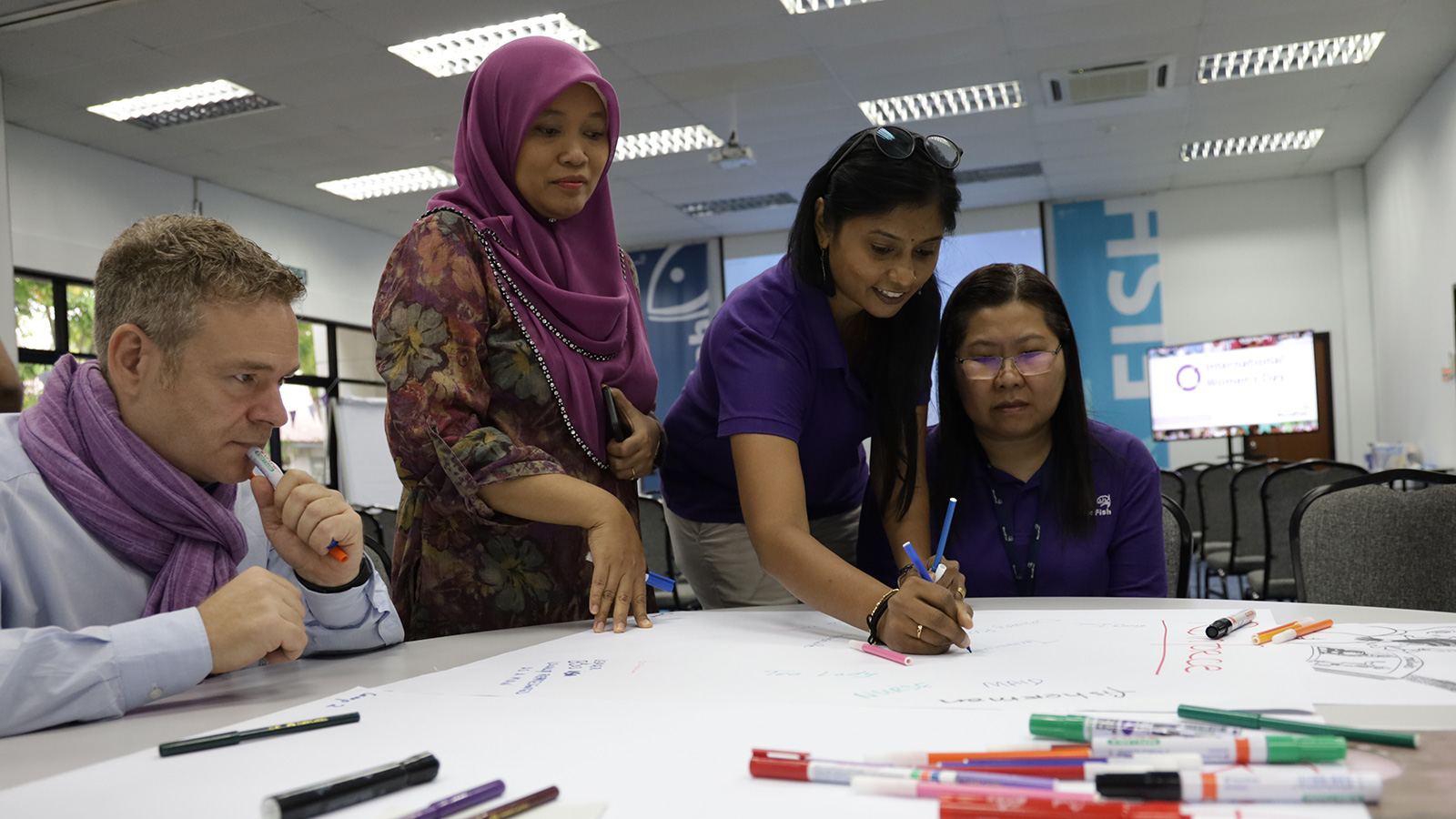
World Cafe session at WorldFish HQ, Penang. Photo: WorldFish
Can you think of a success story where integrating gender in fisheries has led to more inclusive decision-making?
In Fiji, what’s been inspiring for me is the emergence of women leaders in the rural space when they receive investment or training. I’m specifically thinking of a community leader named Taru Veibi who has worked to improve fish stocks in customary fishing grounds in the Bau Province in Fiji. She is very astute in navigating male spaces and is getting invited to spaces where they are discussing natural resource management. Through her leadership, she is bringing women’s voices to these conversations, typically reserved for chiefs and heads of clans. This example shows that when you make the investment, you can elevate individual champions which can then have a trickle-down effect on more inclusive decision-making.
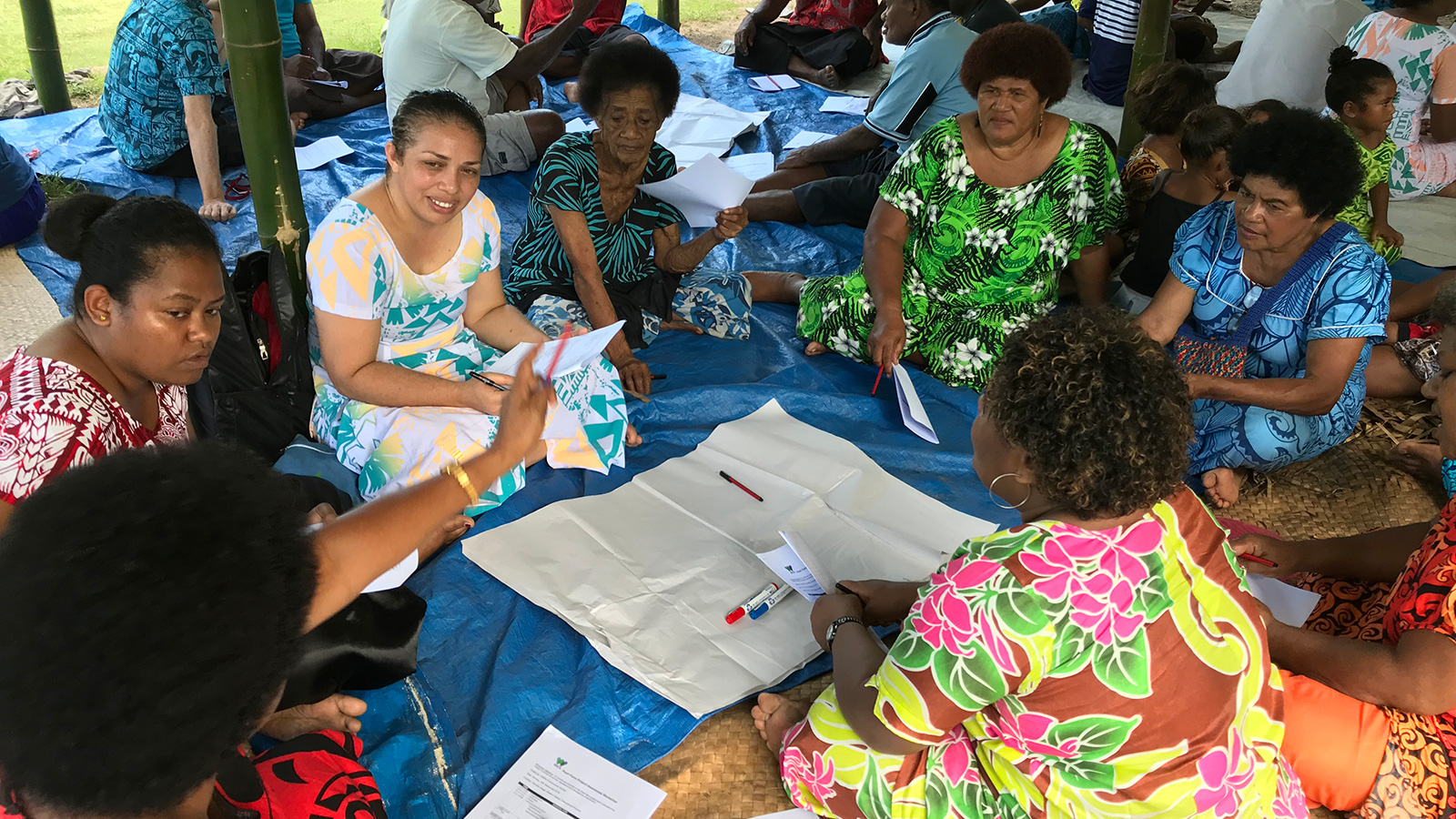
Pearl farming workshop, Vatulele Village, Fiji. Photo: WCS Fiji
What are the most promising solutions for rebalancing opportunities for women in conservation and fisheries? Are there specific actions that marine funders and NGOs can take to support this growth?
First, we need to be active about integrating gender into all sectors including conservation and fisheries and not assume it will happen passively. To see real change, we need institutions first to change because the approaches they use affects how projects are designed, prioritized, funded, and implemented on the ground.
First, we need to be active about integrating gender into all sectors including conservation and fisheries and not assume it will happen passively. To see real change, we need institutions first to change because the approaches they use affects how projects are designed, prioritized, funded, and implemented on the ground.
Second, we need to make sure that we are disaggregating data and looking at the ways women and other marginalized groups are being represented or not. This can help us understand and appreciate that beyond gender (which is not binary), there are other social factors that might determine a person’s ability to engage in decisions on fisheries or conservation.
Third, we need to make sure gender equity and social inclusion, as well as environmental and social justice, are adequately articulated in policies and commitments around natural resources.
Lastly, conservation organizations need to provide training to their staff. Very few individuals working in conservation have a background in the gendered components of conservation. We have a real opportunity to engage closely with gender experts, including those in the gender development space. The good news is that we aren’t starting our gender journey from zero. We have decades of learning and investment to build upon in fast tracking our support.
The good news is that we aren’t starting our gender journey from zero. We have decades of learning and investment to build upon in fast tracking our support.

